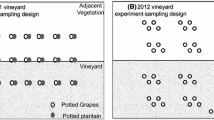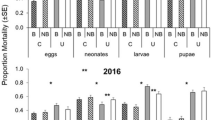Abstract
Two field experiments were conducted in Hawaii to determine the responses of lepidopteran pests and their associated natural enemies to broccoli (Brassica oleracea), grown in monoculture or interplanted with chili pepper (Capsicum annuum), or yellow sweetclover (YSC) (Melilotus officinalis). The population responses of Artogeia rapae and Trichoplusia ni to habitat types were not consistent during the field trials. Additionally, their reactions to habitat diversification differed according to non-host plant species. For example, Trichoplusia ni densities were significantly lower in the broccoli–YSC habitat contrasted with the broccoli–pepper habitat on most sampling dates. Similarly, the proportion of plants damaged by Hellula undalis was significantly lower in the broccoli–YSC habitat contrasted with broccoli–pepper habitat. Findings from the study, suggest that biological control agents (e.g., spiders, parasitoids, and␣entomopathogens) are the most significant factors influencing the abundance of A.␣rapae in habitat type and that these agents inflict greater mortality on A. rapae in diculture than monoculture habitats.
Similar content being viewed by others
References
Altieri M.A. and Gliessman S.R. (1983). Effects of plant diversity on the density and herbivory of the flea beetle, Phyllotreta cruciferae Goez, in California collard (Brassica oleracea) cropping systems. Crop Prot. 2: 497–501
Andow D.A., Nicholson A.G., Wien H.C. and Willson H.R. (1986). Insect population on cabbage grown with living mulches. Environ. Entomol. 15: 293–299
Andow D.A. (1991). Vegetational diversity and arthropod population response. Annu. Rev. Entomol. 36: 561–586
Bach C.E. and Tabashnik B.E. (1990). Effects of nonhost plant neighbors on population densities and parasitism rates of the diamondback moth (Lepidoptera: Plutellidae). Environ. Entomol. 19: 987–994
den Belder E., Valcheva R.I. and Guldemond J.A. (1999). Increased damage by western flower thrips, Frankliniella occidentalis, in chrysanthemum intercropped with subterranean clover. Entomol. Exp. Appl. 91: 275–285
Costello M.J. and Altieri M.A. (1995). Abundance, growth rate and parasitism of Brevicoryne brassicae and Myzus persicae (Homoptera: Aphididae) on broccoli grown in living mulches. Agric. Ecosyst. Environ. 52: 187–196
Cromartie W.J., Jr (1975). The effect of stand size and vegetational background on the colonization of cruciferous plants by herbivorous insects. J. Appl. Ecol. 12: 517–533
Ekesi S., Maniania N.K., Ampong-Nyarko K. and Onu I. (1999). Effect of intercropping cowpea with maize on the performance of Metarhizium anisopliae against Megalurothrips sjostedti (Thysanoptera: Thripidae) and predators. Environ. Entomol. 28: 1154–1161
Gupta P.D. and Thorsteinson A.J. (1960). Food plant relationships of the diamondback moth (Plutella maculipennis (Curt.)). II. Sensory regulation of oviposition of the adult female. Entomol. Exp. Appl. 3: 305–314
Haji-Mamat H. and Tamashiro M. (1988). The prevalence of infections of Nosema meslini (Microsporida: Nosematidae) in field populations of Artogeia rapae (Lepidoptera: Pieridae) adults in Hawaii. Proc. Hawaii Entomol. Soc. 8: 191–196
Hofsvang T. (1991). The Influence of intercropping and weeds on the oviposition of the brassica root flies (Delia radicum and D. floralis). Nor. J. Agri. Sci. 5: 349–356
Hooks C.R.R., Valenzuela H.R. and Defrank J. (1998). Incidence of pests and arthropod natural enemies in zucchini grown with living mulches. Agric. Ecosyst. Environ. 69: 217–231
Hooks C.R.R. and Johnson M.W. (2001). Broccoli growth parameters and level of head infestations in simple and mixed plantings: Impact of increased flora diversification. Ann. Appl. Biol. 138: 269–280
Hooks C.R.R. and Johnson M.W. (2002). Lepidopterous pest populations and crop yields in row intercropped broccoli. Agric. For. Entomol. 4: 117–126
Hooks C.R.R., Pandey R.R. and Johnson M.W. (2003). Impact of avian and arthropod predation on lepidopteran caterpillar densities and plant productivity in an ephemeral agroecosystem. Ecol. Entomol. 28: 522–532
Horn D.J. (1981). Effect of weedy backgrounds on colonization of collards by green peach aphid, Myzus persicae, and its major predators. Environ. Entomol. 10: 285–289
Ives P.M. (1978). How discriminating are cabbage butterflies?. Aust. J. Ecol. 3: 261–276
Jones R.E. (1977). Movement patterns and egg distribution in cabbage butterflies. J. Anim. Ecol. 46: 195–212
Kemp J.C. and Barrett G.W. (1989). Spatial patterning: Impact of uncultivated corridors on arthropod populations within soybean agroecosystems. Ecology 70: 114–128
Landolt P.J. (1989). Attraction of the cabbage looper to host plant and host plant odor in the laboratory. Entomol. Exp. Appl. 53: 117–124
Landolt P.J. (1993). Effects of host plant leaf damage on cabbage looper moth attraction and oviposition. Entomol. Exp. Appl. 67: 79–85
Langer V. (1996). Insect–crop interactions in a diversified cropping system: Parasitism by Aleochara bilineata and Trybliographa rapae of the cabbage root fly, Delia radicum, on cabbage in the presence of white clover. Entomol. Exp. Appl. 80: 365–374
Lanini, W.T., D.R. Pittenger, W.L. Graves, F. Munoz and H.S. Agamalian, 1989. Subclovers as living mulches for managing weeds in vegetables. Calif. Agric. Nov–Dec: 25–27
Latheef M.A. and Irwin R.D. (1979). The effect of companionate plantings on lepidopteran pests of cabbage. Can. Entomol. 111: 863–864
Latheef M.A. and Ortiz J.H. (1983). The influence of companion herbs on egg distribution of the imported cabbageworm, Pieris rapae (Lepidoptera, Pieridae), on collard plants. Can. Entomol. 115: 1031–1038
McLeod E. (1982). Feed the Soil. Organic Agriculture Research Institute, Graton, CA
Myers J., (1985). Effect of physiological condition of the host plant on the ovipositional choice of the cabbage white butterfly Pieris rapae. J. Anim. Ecol. 54: 193–204
Pimentel D. (1961). Species diversity and insect population outbreaks. Ann. Entomol. Soc. Am. 54: 76–86
Quinn G.P. and Keough M.J. (2002). Experimental Design and Data Analysis for Biologists. Cambridge University Press, Cambridge
Radcliffe E.B. and Chapman R.K. (1965). Seasonal shifts in the relative resistance to insect attack of eight commercial cabbage varieties. Ann. Entomol. Soc. Am. 58: 892–897
Root R.B. (1973). Organization of a plant–arthropod association in simple and diverse habitats: The fauna of collards (Brassica oleracea). Ecol. Monogr. 43: 95–120
Russell E.P., (1989). Enemies hypothesis: A review of the effect of vegetational diversity on predatory insects and parasitoids. Environ. Entomol. 18: 590–599
SAS Institute, 1990. SAS User’s Guide: Statistics. Cary, NC.
Sato Y., Yano S., Takabayashi J. and Ohsaki N. (1999). Pieris rapae (Lepidoptera: Pieridae) females avoid oviposition on Rorippa indica plants infested by conspecific larvae. Appl. Entomol. Zool. 34: 333–337
Schellhorn N.A. and Sork V.L. (1997). The impact of weed diversity on insect population dynamics and crop yield in collards, Brassica oleracea (Brassicaceae). Oecologia 111: 233–240
Sheehan E. (1986). Response by specialist and generalist natural enemies to agroecosystem diversification: A selective review. Environ. Entomol. 15: 456–461
Singer M.C. (1986). The definition and measurement of oviposition preference in plant-feeding insects. In: Miller J.R. and Miller T.A. (eds) Insect–Plant Interactions. Berlin, Springer Verlag, pp. 159–202
Smith J.G. (1976). Influence of crop background on aphids and other phytophagous insects on brussels sprouts. Ann. Appl. Biol. 83: 1–13
Steel R.G.D. and Torrie J.H. (1980). Principle and Procedures of Statistics: A Biomedical Approach, 2nd ed. McGraw-Hill, New York
Tabashnik B.E. (1985). Deterrence of diamondback moth (Lepidoptera: Plutellidae) oviposition by plant compounds. Environ. Entomol. 14: 575–578
Tabashnik B.E. (1987). Plant secondary compounds as oviposition deterrents for cabbage butterfly, Pieris rapae (Lepidoptera: Pieridae). J. Chem. Ecol. 13: 309–316
Takeda K.Y., Tanaka J.S., Sekioka T.T. and Hamilton R.A.(1996). ‘Kaala’ and ‘Waialua’ peppers. HortScience 31: 1054
Tanada Y. and Kaya H.K. (1993). Insect Pathology. Academic Press, Inc. San Diego, CA
Theunissen J.C., Booij J.H. and Lotz L.A.P. (1995). Effects of intercropping white cabbage with clovers on pest infestation and yield. Entomol. Exp. Appl.74: 7–16
Theunissen J. and Schelling G. (1996). Undersowing crops of white cabbage with strawberry clover and spurrey. IOBC/WPRS Bull.19: 128–135
van Emden H.F. and Peakall D.B. (1996). Beyond Silent Spring: Integrated pest management and chemical safety. Chapman and Hall, New York
Vidal S. (1997). Factors influencing the population dynamics of Brevicoryne brassicae in undersown brussels sprout. Biol. Agric. Hort. 15: 285–295
Wolfson J.L. (1980). Oviposition response of Pieris rapae to environmentally induced variation in Brassica nigra. Entomol. Exp. Appl. 27: 223–232
Acknowledgements
The authors thank E. Acierto, J. B. Carder, D. Ohora, R. R. Pandey, K.-H. Wang, and employees and volunteers at the University of Hawaii’s Poamoho Research Station for field assistance; K. Takeda for horticultural support; L. Lebeck, H. Kaya, and T. Tamashiro for␣entomopathogen identification; D. Tsuda, B. Kumashiro, and R.␣G. Gillespie for insect and spider identifications, respectively; R.␣F.␣L. Mau, J. J. McHugh, and J. Rosenheim, for thoughtful suggestions; O. Kawabata for statistical advice; and A. Alyokhin for suggestions in reviewing the manuscript. This study was partially funded by the USDA/CSREES, Special Grant for Tropical and Subtropical Agriculture Research (T-STAR), Agreement No. 99-34135-8109.
Author information
Authors and Affiliations
Corresponding author
Rights and permissions
About this article
Cite this article
Hooks, C.R.R., Johnson, M.W. Population densities of herbivorous lepidopterans in diverse cruciferous cropping habitats: Effects of mixed cropping and using a living mulch. Biocontrol 51, 485–506 (2006). https://doi.org/10.1007/s10526-006-9009-5
Received:
Accepted:
Published:
Issue Date:
DOI: https://doi.org/10.1007/s10526-006-9009-5




